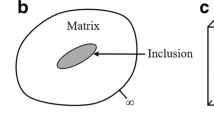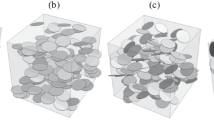Abstract
In this paper, a data-driven-based computational homogenization method based on neural networks is proposed to describe the nonlinear electric conduction in random graphene-polymer nanocomposites. In the proposed technique, the nonlinear effective electric constitutive law is provided by a neural network surrogate model constructed through a learning phase on a set of RVE nonlinear computations. In contrast to multilevel (FE\(^2\)) methods where each integration point is associated with a full nonlinear RVE calculation, the nonlinear macroscopic electric field-electric flux relationship is efficiently evaluated by the surrogate neural network model, reducing drastically (by several order of magnitudes) the computational times in multilevel calculations. Several examples are presented, where the RVE contains aligned graphene sheets embedded in a polymer matrix. The nonlinear behavior is due to the modeling of the tunelling effect at the scale of graphene sheets.



















Similar content being viewed by others
Notes
Synaptic weights may range in positive as well as negative values.
Training of the ANN can be considered as an optimization problem, where the design variables are the synaptic weights.
References
Feyel F (1999) Multiscale FE\(^2\) elastoviscoplastic analysis of composite structure. Comput Mater Sci 16(1–4):433–454
Feyel F, Chaboche JL (2000) FE\(^2\) multiscale approach for modelling the elastoviscoplastic behaviour of long fibre SiC/Ti composite materials. Comput Methods Appl Mech Eng 183(3–4):309–330
Smit R, Brekelmans W, Meijer H (1998) Prediction of the mechanical behavior of nonlinear heterogeneous systems by multi-level finite element modeling. Comput Methods Appl Mech Eng 155(1–2):181–192
Miehe C, Schröder J, Schotte J (1999) Computational homogenization analysis in finite plasticity simulation of texture development in polycrystalline materials. Comput Methods Appl Mech Eng 171(3–4):387–418
Terada K, Kikuchi N (2001) A class of general algorithms for multi-scale analysis of heterogeneous media. Comput Methods Appl Mech Eng 190:5427–5464
Kouznetsova V, Brekelmans W, Baaijens F (2001) An approach to micro–macro modeling of heterogeneous materials. Comput Mech 27(1):37–48
Ghosh S, Lee K, Raghavan P (2001) A multi-level computational model for multi-scale damage analysis in composite and porous materials. Int J Solids Struct 38(14):2335–2385
Ibrahimbegović A, Markovič D (2003) Strong coupling methods in multi-phase and multi-scale modeling of inelastic behavior of heterogeneous structures. Comput Methods Appl Mech Eng 192(28–30):3089–3107
Yvonnet J, He QC (2007) The reduced model multiscale method (R3M) for the non-linear homogenization of hyperelastic media at finite strains. J Comput Phys 223(1):341–368
Ibrahimbegovic A, Papadrakakis M (2010) Multi-scale models and mathematical aspects in solid and fluid mechanics. Comput Methods Appl Mech Eng 199:1241–1241
Fullwood DT, Niezgoda SR, Adams BL, Kalidindi SR (2010) Microstructure sensitive design for performance optimization. Progr Mater Sci 55(6):477–562
Papadopoulos V, Impraimakis M (2017) Multiscale modeling of carbon nanotube reinforced concrete. Compos Struct 182:251–260
Geers MG, Kouznetsova VG, Brekelmans W (2010) Multi-scale computational homogenization: trends and challenges. J Comput Appl Math 234(7):2175–2182
Geers M, Yvonnet J (2016) Multiscale modeling of microstructure-property relations. MRS Bull 41(08):610–616
Hernández J, Oliver J, Huespe AE, Caicedo M, Cante J (2014) High-performance model reduction techniques in computational multiscale homogenization. Comput Methods Appl Mech Eng 276:149–189
Zahr MJ, Avery P, Farhat C (2017) A multilevel projection-based model order reduction framework for nonlinear dynamic multiscale problems in structural and solid mechanics. Int J Numer Methods Eng 112(8):855–881
Liu Z, Bessa M, Liu WK (2016) Self-consistent clustering analysis: an efficient multi-scale scheme for inelastic heterogeneous materials. Comput Methods Appl Mech Eng 306:319–341
Yvonnet J, Gonzalez D, He QC (2009) Numerically explicit potentials for the homogenization of nonlinear elastic heterogeneous materials. Comput Methods Appl Mech Eng 198(33–36):2723–2737
Le BA, Yvonnet J, He QC (2015) Computational homogenization of nonlinear elastic materials using neural networks. Int J Numer Methods Eng 104(12):1061–1084
Bessa M, Bostanabad R, Liu Z, Hu A, Apley DW, Brinson C, Chen W, Liu WK (2017) A framework for data-driven analysis of materials under uncertainty: countering the curse of dimensionality. Comput Methods Appl Mech Eng 320:633–667
Fritzen F, Kunc O (2017) Two-stage data-driven homogenization for nonlinear solids using a reduced order model. Eur J Mech A Solids 69:201–220
Ghaboussi J, Garrett J Jr, Wu X (1991) Knowledge-based modeling of material behavior with neural networks. J Eng Mech 117(1):132–153
Furukawa T, Yagawa G (1998) Implicit constitutive modelling for viscoplasticity using neural networks. Int J Numer Methods Eng 43(2):195–219
Lefik M, Schrefler B (2003) Artificial neural network as an incremental non-linear constitutive model for a finite element code. Comput Methods Appl Mech Eng 192(28–30):3265–3283
Yun GJ, Ghaboussi J, Elnashai AS (2008) A new neural network-based model for hysteretic behavior of materials. Int J Numer Methods Eng 73(4):447–469
Peherstorfer B, Willcox K (2015) Dynamic data-driven reduced-order models. Comput Methods Appl Mech Eng 291:21–41
Kirchdoerfer T, Ortiz M (2016) Data-driven computational mechanics. Comput Methods Appl Mech Eng 304:81–101
Versino D, Tonda A, Bronkhorst CA (2017) Data driven modeling of plastic deformation. Comput Methods Appl Mech Eng 318:981–1004
Kirchdoerfer T, Ortiz M (2017) Data driven computing with noisy material data sets. Comput Methods Appl Mech Eng 326:622–641
Ibañez R, Abisset-Chavanne E, Aguado JV, Gonzalez D, Cueto E, Chinesta F (2018) A manifold learning approach to data-driven computational elasticity and inelasticity. Arch Comput Methods Eng 25(1):47–57
Nguyen LTK, Keip MA (2018) A data-driven approach to nonlinear elasticity. Comput Struct 194:97–115
Waszczyszyn Z, Ziemiański L (2001) Neural networks in mechanics of structures and materials—new results and prospects of applications. Comput Struct 79(22–25):2261–2276
Zhao H, Bai J (2015) Highly sensitive piezo-resistive graphite nanoplatelet-carbon nanotube hybrids/polydimethylsilicone composites with improved conductive network construction. ACS Appl Mater Interfaces 7(18):9652–9659
Park OK, Jeevananda T, Kim NH, Kim S, Lee JH (2009) Effects of surface modification on the dispersion and electrical conductivity of carbon nanotube/polyaniline composites. Scr Mater 60(7):551–554
Jia J, Sun X, Lin X, Shen X, Mai YW, Kim JK (2014) Exceptional electrical conductivity and fracture resistance of 3d interconnected graphene foam/epoxy composites. ACS Nano 8(6):5774–5783
Wang T, Liang G, Yuan L, Gu A (2014) Unique hybridized graphene and its high dielectric constant composites with enhanced frequency stability, low dielectric loss and percolation threshold. Carbon 77:920–932
Wei T, Luo G, Fan Z, Zheng Yan J, Yao C, Li W, Zhang C (2009) Preparation of graphene nanosheet/polymer composites using in situ reduction-extractive dispersion. Carbon 47(9):2296–2299
Pang H, Chen T, Zhang G, Zeng B, Li ZM (2010) An electrically conducting polymer/graphene composite with a very low percolation threshold. Mater Lett 64(20):2226–2229
Wang J, Yu S, Luo S, Chu B, Sun R, Wong CP (2016) Investigation of nonlinear I–V behavior of CNTs filled polymer composites. Mater Sci Eng B 206:55–60
Martin-Gallego M, Bernal MM, Hernandez M, Verdejo R, López-Manchado MA (2013) Comparison of filler percolation and mechanical properties in graphene and carbon nanotubes filled epoxy nanocomposites. Eur Polym J 49(6):1347–1353
Zeng X, Xu X, Kovalev PMSE, Baudot C, Mathews N, Zhao Y (2011) Characteristics of the electrical percolation in carbon nanotubes/polymer nanocomposites. J Phys Chem C 115(44):21685–21690
Lu X, Yvonnet J, Detrez F, Bai J (2017) Multiscale modeling of nonlinear electric conductivity in graphene-reinforced nanocomposites taking into account tunnelling effect. J Comput Phys 337:116–131
Yvonnet J, He QC, Toulemonde C (2008) Numerical modelling of the effective conductivities of composites with arbitrarily shaped inclusions and highly conducting interface. Compos Sci Technol 68(13):2818–2825
Lu X, Yvonnet J, Detrez F, Bai J (2018) Low electrical percolation thresholds and nonlinear effects in graphene-reinforced nanocomposites: a numerical analysis. J Compos Mater 52(20):2767–2775
Simmons JG (1963) Electric tunnel effect between dissimilar electrodes separated by a thin insulating film. J Appl Phys 34(9):2581–2590
Gu S, He QC (2011) Interfacial discontinuity relations for coupled multifield phenomena and their application to the modeling of thin interphases as imperfect interfaces. J Mech Phys Solids 59(7):1413–1426
Eglajs V, Audze P (1977) New approach to the design of multifactor experiments. Probl Dyn Strengths 35(1):104–107
Stankovich S, Dikin DA, Dommett GHB, Kohlhaas KM, Zimney EJ, Stach EA, Piner RD, Nguyen ST, Ruoff RS (2006) Graphene-based composite materials. Nature 442(7100):282–286
Cybenko G (1989) Approximation by superpositions of a sigmoidal function. Math Control Signals Syst 2(4):303–314
Acknowledgements
The financial support from Institut Universitaire de France (IUF) is gratefully acknowledged for JY.
Author information
Authors and Affiliations
Corresponding author
Additional information
Publisher's Note
Springer Nature remains neutral with regard to jurisdictional claims in published maps and institutional affiliations.
Rights and permissions
About this article
Cite this article
Lu, X., Giovanis, D.G., Yvonnet, J. et al. A data-driven computational homogenization method based on neural networks for the nonlinear anisotropic electrical response of graphene/polymer nanocomposites. Comput Mech 64, 307–321 (2019). https://doi.org/10.1007/s00466-018-1643-0
Received:
Accepted:
Published:
Issue Date:
DOI: https://doi.org/10.1007/s00466-018-1643-0




